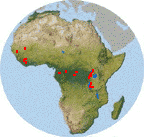African Ape Study Sites
 This website contains ecological and demographic data, maps, photographs, and research bibliographies pertinent to chimpanzee, gorilla and bonobo field research studies. It is a result of a collaborative effort between
Dr. Jim Moore of UCSD, and Melissa Collier, a Master's student at Cal State
Fullerton. JM created the concept and MC did the bulk of the initial setup
as part of a summer 1998 internship with the California Pre-Doctoral Program.
From Sept. 1998 on, JM is responsible. Many thanks, Melissa!
This website contains ecological and demographic data, maps, photographs, and research bibliographies pertinent to chimpanzee, gorilla and bonobo field research studies. It is a result of a collaborative effort between
Dr. Jim Moore of UCSD, and Melissa Collier, a Master's student at Cal State
Fullerton. JM created the concept and MC did the bulk of the initial setup
as part of a summer 1998 internship with the California Pre-Doctoral Program.
From Sept. 1998 on, JM is responsible. Many thanks, Melissa!
The maps, photos, and data here are accurate to the best of our knowledge.
Site report information is mostly from McGrew et. al. (1996), Great
Ape Societies (Cambridge University Press) but with some additions/modifications
though, and one should check that book for citation purposes (and contact
Jim Moore for explanation of discrepancies).
The initial emphasis is on the Tanzanian sites of Gombe, Mahale, and Ugalla (mainly because I've been to all of them and have photos). I don't consider these sites "done" but they do give an idea of what I'm aiming at.
CONTRIBUTIONS are very welcome, both "filling in the blanks" that exist within the current format, and suggesting additional site data that would be useful to include here. Ideally, each study site
would be represented by 6-8 habitat photos, a topographical map, aerial
photos, a listing of plant & animal taxa, and as much climatological
data as possible (to get at variability). Any researchers who can contribute
to this, either advice or materials, please contact me; I can handle any
scanning, formatting etc needed at this end. Email: jjmoore@ucsd.edu
Site bibliographies are welcome, especially if they include "non-obvious" references: works on ecology, geology, history, non-primate taxa, etc. Ideally these would be sent to me in EndNote-compatible format, but any electronic format is OK. Eventually we (Greg Laden has kindly offered to help) will get them into EndNote and then be able to offer both alphabetical and chronological versions.
If you arrived at this page directly from "outside", you might want to check with the cover page for some miscellaneous details about what this site is intended to accomplish, who it is aimed at and all that good stuff.
| West Africa |
Central Africa |
East Africa |
| Tai NP, Ivory Coast |
Kahuzi-Biega NP, D. R. Congo |
Gombe NP, Tanzania |
| Bafing Region, Mali |
Lomako, D. R. Congo |
Mahale Mountains NP, Tanzania |
| Mt. Assirik, Senegal |
Wamba, D. R. Congo |
Ugalla, Tanzania |
| Bossou, Guinea |
Nouabale-Ndoki, R. P. Congo |
Kibale NP, Uganda |
| Nimba Mtns, Guinea/Ivory Coast/Liberia |
Lope, Gabon |
Budongo Forest Reserve, Uganda |
|
Lukuru, D. R. Congo
Note: this is to an external link; site entry here is in progress. |
Bwindi-Impenetrable Forest, Uganda |
|
Mbeli Bai (site in Nouabale-Ndoki NP, R. P. Congo) |
Semliki, Uganda |
|
|
Karisoke NP, Rwanda |
|
|
Ishasha R., D. R. Congo |
Can't find a site? It takes a while for (a) new study sites to become established and start publishing, and (b) me to update this website. In the meantime, for brief updates etc. see Gorilla Conservation News and for chimpanzees, see Pan Africa News. Heck, subscribe to (i.e., support) them! ALSO, have a look at MK Holder's site descriptions and photos at East African Research Sites; she has information on Ishasha, Kibale, and Karisoke.
Acknowledgments
The nature of this web site makes it difficult to thank in a general way all those agencies, governments and people without whom the work would be impossible. I am also concerned that if some site pages have acknowledgments while others do not (perhaps because the relevant PIs are in the field without web access), the later might seem ungrateful. For these reasons at least initially I want to establish a general rule that funding agencies and governments not be specifically acknowledged here--while noting that all of us deeply appreciate their support and permission.That said, one foundation does deserve specific mention: the LSB Leakey Foundation has supported field research on African apes at many sites in many countries, and has probably contributed to the great majority of the studies included here.
 Last update: 28 Jan 1999
Last update: 28 Jan 1999
 This website contains ecological and demographic data, maps, photographs, and research bibliographies pertinent to chimpanzee, gorilla and bonobo field research studies. It is a result of a collaborative effort between
Dr. Jim Moore of UCSD, and Melissa Collier, a Master's student at Cal State
Fullerton. JM created the concept and MC did the bulk of the initial setup
as part of a summer 1998 internship with the California Pre-Doctoral Program.
From Sept. 1998 on, JM is responsible. Many thanks, Melissa!
This website contains ecological and demographic data, maps, photographs, and research bibliographies pertinent to chimpanzee, gorilla and bonobo field research studies. It is a result of a collaborative effort between
Dr. Jim Moore of UCSD, and Melissa Collier, a Master's student at Cal State
Fullerton. JM created the concept and MC did the bulk of the initial setup
as part of a summer 1998 internship with the California Pre-Doctoral Program.
From Sept. 1998 on, JM is responsible. Many thanks, Melissa!